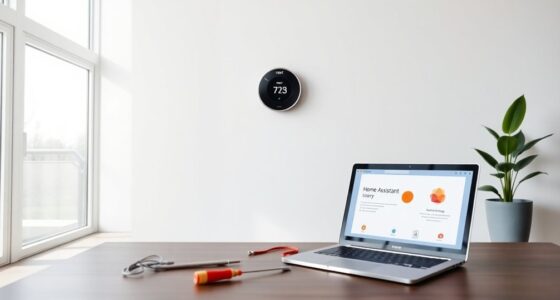When a ceiling fan is labeled "remote ready," it means you're set to control the fan with a remote, bypassing manual adjustments like pull chains or wall switches. This design includes a built-in receiver that communicates seamlessly with the remote, allowing you to change speeds and lights from anywhere in the room. It's especially handy in high-ceiling areas. Make certain the remote is compatible with your specific fan model to guarantee proper function. If you're curious about more features and benefits of these remote ready fans, there's plenty more to explore!
Key Takeaways
- "Remote Ready" ceiling fans are equipped with built-in technology for operation via a remote control, eliminating manual adjustments.
- These fans typically include a compatible remote for easy speed and light adjustments, ideal for hard-to-reach areas.
- They use Radio Frequency (RF) technology, allowing control from anywhere in the room without needing a direct line of sight.
- Remote controls can manage multiple fans simultaneously and often include several speed settings and light functions.
- It's essential to verify compatibility with existing systems to ensure the remote control matches the fan model for proper functionality.
Definition of Remote Ready
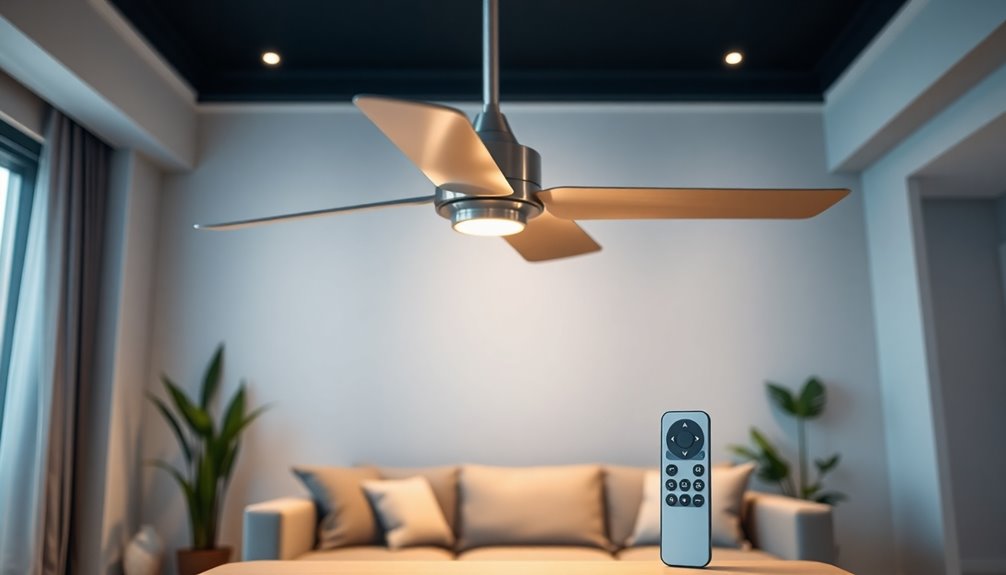
When it comes to ceiling fans, "Remote Ready" means they've got the built-in capabilities to operate with a remote control. This design eliminates the hassle of manual adjustments through pull chains or wall switches.
Most remote-ready ceiling fans include a compatible remote, letting you easily adjust fan speed and light settings from anywhere in the room. These fans come equipped with a receiver that communicates with the remote, making installation a breeze without complex wiring changes.
Remote-ready ceiling fans are especially convenient in high-ceiling areas or spaces where traditional controls are hard to reach. Plus, many models offer multiple fan speeds and light dimming options, giving you greater flexibility to create the perfect atmosphere and comfort in your home.
How Remote Controls Work

Ceiling fan remote controls operate using Radio Frequency (RF) technology, which allows you to control your fan without needing a direct line of sight.
This versatility means you can adjust your ceiling fan from anywhere in the room. Most ceiling fan remotes come with multiple speed settings and a light on/off function, with some even offering dimmer capabilities.
One advantage of RF remotes is their ability to manage multiple fans simultaneously without interference.
However, if you retrofit a ceiling fan with a remote, you might lose the pull cord functionality, as the fan will mainly respond to the remote.
If you ever need a replacement, just make sure it's compatible with your specific ceiling fan model for proper functionality.
Benefits of Remote Ready Fans

Why struggle with inconvenient pull chains or wall switches when you can enjoy the ease of remote ready fans? These fans come equipped with the necessary hardware for convenient operation, allowing you to integrate remote control functionality without extra wiring.
You'll appreciate the ability to manage multiple speeds and light settings through a remote, enhancing your comfort in any room. Remote ready fans also improve accessibility, especially in high ceilings or tight spaces where pulling a chain is a hassle.
Plus, many are compatible with smart home systems, enabling control via mobile apps or voice commands. By turning off the fan when it's not needed, you can even save on energy costs, making them a smart choice for any home.
Compatibility With Existing Systems
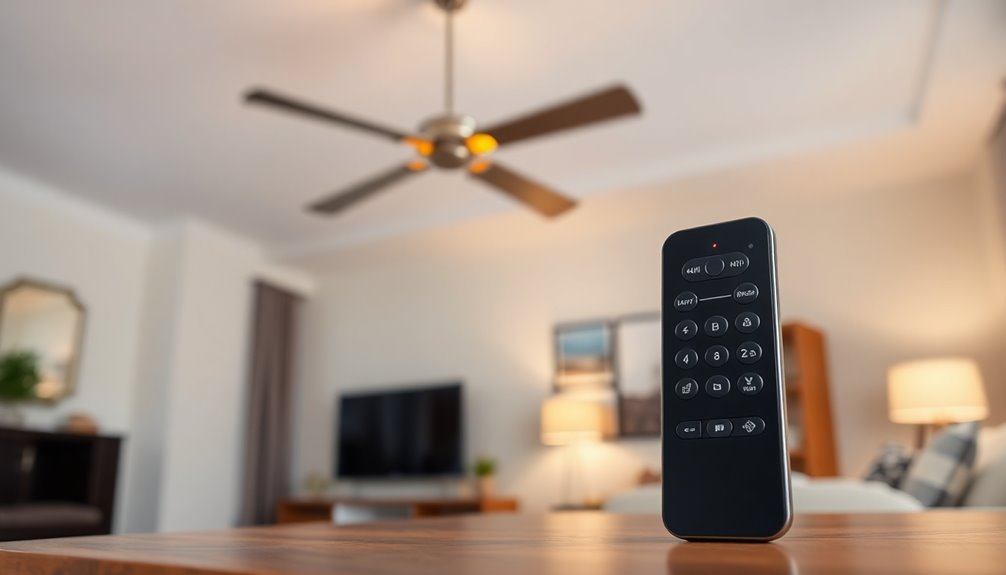
While you may be excited about the convenience of remote ready fans, it's important to verify they fit seamlessly with your existing systems. Many remote ready fans come with a pre-installed receiver, making it easy to connect to a compatible remote without extra wiring.
However, compatibility can vary, so you'll want to confirm that the remote control matches your fan model for proper functionality. Additionally, some fans might lose certain control options, like pull cords or wall switches, when retrofitted with remotes. This could impact how your fan integrates into your setup.
Before purchasing, double-check compatibility with your smart home hub or virtual assistant to verify an efficient operation.
Installation Considerations

When considering the installation of a remote ready fan, it's vital to assess several factors to guarantee a smooth setup.
First, verify the fan's mounting bracket is compatible with the built-in receiver to avoid connectivity issues. Many models include a remote control, simplifying the installation process. However, some fans may require specific programming to sync with the remote, so be sure to follow the manufacturer's instructions closely.
Additionally, check the location of the power source and confirm that your ceiling box is rated for fan support, as this fan's extra weight and functionality need it. Proper installation can also improve the fan's airflow efficiency, contributing to enhanced comfort and energy savings.
For best results, don't hesitate to seek professional advice to verify everything's set up correctly and safely.
Troubleshooting Common Issues
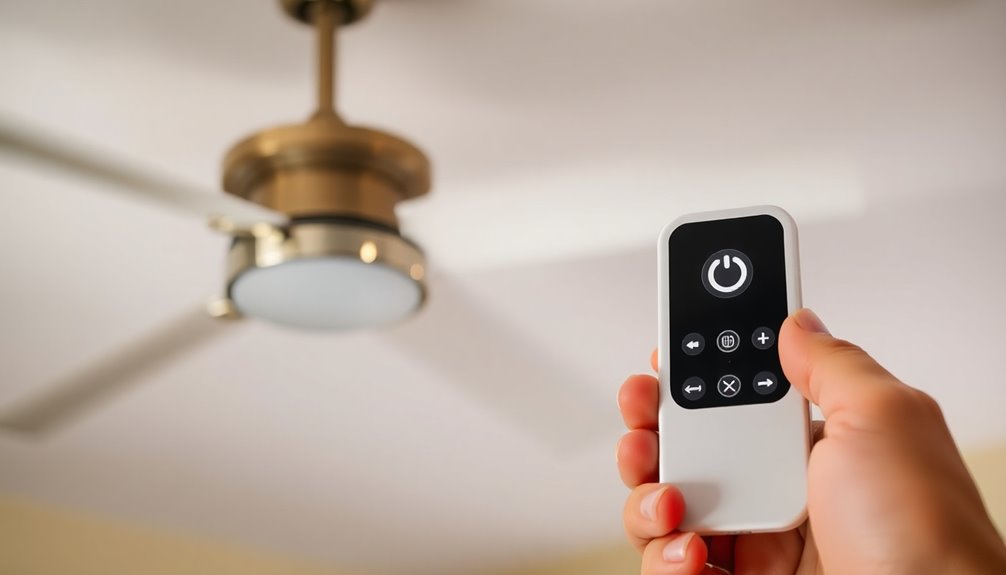
When your ceiling fan remote isn't working, it can be frustrating.
You might face issues like remote control malfunctions, wiring configuration problems, or compatibility with your fan model.
Let's go through some common troubleshooting steps to get your fan back in action.
Remote Control Malfunctions
Remote control malfunctions can be frustrating, especially when you rely on your ceiling fan for comfort.
If your fan doesn't respond or seems to act erratically, here are some common issues to check:
- Replace dead batteries in the remote control.
- Confirm the fan comes away from other electronic devices that might cause interference.
- Verify wiring connections match the remote settings.
- Regularly clean the remote and receiver to prevent dust buildup.
Wiring Configuration Issues
If your ceiling fan isn't responding to the remote, wiring configuration issues might be the culprit.
First, double-check that the black wire from the ceiling connects to the black wire of the fan, the white wire to the fan's white wire, and verify the ground wire is properly attached for safety.
If the receiver wiring is incorrectly configured, it can cause operational conflicts with the remote, so make sure everything matches the remote settings.
If your fan still operates improperly, try bypassing the receiver to connect the fan directly to the ceiling wires.
This step can help you determine if the issue lies with the remote or the ceiling fan itself, simplifying your troubleshooting process.
Compatibility With Fan Models
Understanding compatibility between your ceiling fan model and the remote control is essential for seamless operation. If your fan is remote-ready, it means you can control it easily, but issues can arise if compatibility isn't checked.
Here are some common troubleshooting tips:
- Confirm your fan model supports remote operation.
- Check for malfunctioning buttons on the remote.
- Inspect the wiring connections within the fan or receiver.
- Remember that all DC ceiling fans are exclusively remote-operated.
If you're facing issues, verifying compatibility is vital.
Sometimes, a replacement remote may be necessary if the original fails. By ensuring that your fan and remote are compatible, you'll maintain a hassle-free experience enjoying your ceiling fan.
Future Trends in Fan Technology
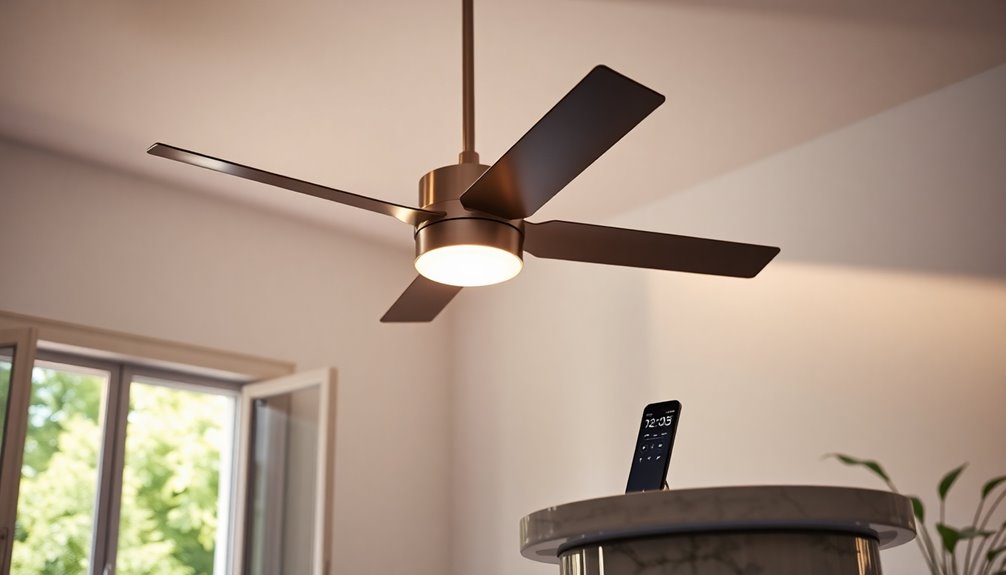
As you consider upgrading to a smart ceiling fan, you'll notice exciting advancements on the horizon.
Enhanced automated features will adjust airflow based on your home's temperature and occupancy, while sustainable energy solutions focus on eco-friendly materials.
Plus, seamless smart home integration will let you control your fan effortlessly alongside other devices.
Enhanced Automated Features
With enhanced automated features on the horizon, ceiling fans are set to revolutionize how you experience comfort in your home. These advancements will integrate seamlessly with smart home systems, allowing you to enjoy greater control and efficiency.
- Built-in sensors will monitor temperature and movement, adjusting fan speed automatically.
- Voice commands through virtual assistants like Alexa or Google Home will make operation effortless.
- Mobile apps will enable customizable settings for speed, lighting, and schedules directly from your smartphone.
- Innovations in remote technology will let you group and control multiple fans simultaneously.
As these features become standard, your ceiling fan will transform into an intelligent device, enhancing your comfort while optimizing energy use. Additionally, these smart ceiling fans can potentially be integrated with heat pump technology, maximizing your home's overall energy efficiency.
Sustainable Energy Solutions
While traditional ceiling fans have always provided a cooling breeze, the future of fan technology is shifting towards sustainable energy solutions that prioritize efficiency and environmental responsibility.
You'll find that energy-efficient designs are at the forefront, helping to reduce electricity consumption. Smart ceiling fans, for instance, can save up to 11% in energy costs by allowing you to raise cooling setpoints.
Advances in sensor technology mean these fans will automatically adjust based on real-time conditions, optimizing comfort and energy use. Additionally, incorporating renewable energy sources like solar panels into fan systems is becoming more common, enhancing sustainability. Furthermore, just like heat pump systems, these innovative fans can improve overall energy efficiency in homes.
With growing consumer demand, expect smart ceiling fans that integrate seamlessly with home automation to lead the market in energy conservation features.
Smart Home Integration
The evolution of ceiling fan technology isn't just about energy efficiency; it's also about how these devices fit into the modern smart home ecosystem.
With smart home integration becoming a standard, you can now control ceiling fans through mobile apps or voice commands using platforms like Alexa and Google Home.
Future trends include:
- Sensors that adjust fan speed based on room temperature and occupancy
- Compatibility with home automation systems for creating routines
- Integration with HVAC systems for better airflow management
- Enhanced features for improved indoor air quality
As consumer demand grows, smart ceiling fans are set to expand considerably, offering you more convenience and energy-efficient solutions for your home. Additionally, understanding how to foster trust through open communication can further enhance the experience of using smart technology in relationships, ensuring that home automation works harmoniously with emotional connectivity.
Frequently Asked Questions
What Is a Remote-Ready Fan?
A remote-ready fan's designed for your convenience, letting you operate it with a remote control. You won't need to fuss with extra wiring or complicated installations.
This fan comes with a built-in receiver, allowing you to easily adjust speeds and control lights from anywhere in the room. Just make sure to check compatibility with your remote model, as not all remote-ready fans work with every remote.
Enjoy the added comfort and ease!
What Are the Disadvantages of Remote Control Ceiling Fans?
When considering remote control ceiling fans, you should weigh some drawbacks.
You might face compatibility issues with remotes, and if your remote malfunctions, you could struggle to operate your fan, especially if it lacks pull cords.
Additionally, you'll need to keep an eye on batteries, as they can die unexpectedly.
Plus, the signal range might limit your control, and you may find these fans pricier than traditional options, impacting your budget.
Why Is My Ceiling Fan Not Responding to Remote?
If your ceiling fan isn't responding to the remote, check a few things first.
Make sure the remote's batteries aren't dead and that it's in working order. If the fan works with the pull chain, the issue is likely the remote.
Also, verify there's a clear line of sight between the remote and the fan's receiver.
Finally, you might need to reset or reprogram the remote according to the manufacturer's instructions.
Can You Turn on a Ceiling Fan Without a Remote?
Imagine a dance partner waiting for you, ready to spin and twirl.
You can often turn on a ceiling fan without a remote, using a pull chain or wall switch instead. Many fans still embrace this manual method, allowing you to control them even if the remote's lost.
Just check the manufacturer's instructions for alternative options, ensuring your fan's always ready to bring a cool breeze into your space.
Conclusion
To sum up, choosing a remote-ready ceiling fan can enhance your comfort and convenience at home. Did you know that nearly 70% of homeowners prefer remote control options for their ceiling fans? This statistic highlights the growing trend towards smart home technologies. By opting for a remote-ready fan, you're not just investing in a stylish fixture; you're embracing a more modern, efficient way to control your indoor climate with ease. Enjoy the benefits and stay ahead of the curve!





